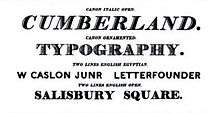Caslon Egyptian

The Two Lines English Egyptian typeface is a font created by the Caslon foundry of London around or probably slightly before 1816, that is the first general-purpose sans-serif typeface in the Latin alphabet known to have been created.[1][2][3][4][lower-alpha 1] A capitals-only design, original matrices of the typeface (with a replacement 'C') survive.[lower-alpha 2] ("English" is an archaic name for its body size.)
Sans-serif lettering had been developing in popularity over the past decades, initially due to interest in classical antiquity in which inscriptions often had minimal or no serifs, and come to be used by architect John Soane and copied by others, particularly in signpainting.[8][9] Historian James Mosley, a leading expert on early sans-serifs, has suggested in his textbook The Nymph and The Grot that Soane's influence was crucial in spreading the idea of sans-serif letterforms around the end of the eighteenth century.[1] However, it was some decades before a printing typeface would be released in this style, now commonly used. Somewhat "classical" in style and not particularly bold (although still bolder than conventional body text fonts), the "Egyptian" typeface appears similar to Soane's lettering. The name "Egyptian" had become commonly used in England by 1816 to describe this style of lettering; it may originate from the image of sans-serifs being historical in style, the Egyptomania of the period and the "blocky" nature of ancient Egyptian architecture.[10] (The term "Egyptian" has since become associated with slab-serif typefaces.)
Caslon's Egyptian typeface was shown in the foundry's specimen books, the earliest edition with a date dated 1816 although some possibly earlier.[lower-alpha 3] It appears in the specimen book sandwiched by larger and much more ornate typefaces, apparently not marketed with any prominence. Aside from its documented existence and survival, the reasons behind its creation are not clear, since no contemporary uses of it have been found. Mosley suggests that it may have been created on commission by a specific client.[11] The matrices were acquired by the Stephenson Blake company among other Caslon foundry materials. With increasing interest in sans-serifs around the early 1830s, the company revived the matrices and matching versions in other sizes (of lower quality of execution) were cut.[7] (These should not be confused with Stephenson Blake's unrelated "Grotesque" typefaces of the late nineteenth century.)
.jpg)
Several digital revivals of Caslon's Egyptian have been made, for commercial use by Font Bureau (adding an invented lower case) and for private use by Justin Howes and James Mosley. Howes' revival is used for signage at Dulwich Picture Gallery, designed by Soane.[12][13][11] In 1987 metal type was cast by Oxford University Press from the original matrices to print a special edition of reprinted type from the early nineteenth century crafted by Ian Mortimer.[14]
To mark the two-hundredth anniversary of the first dated printing of a sans-serif typeface, a conference was held at Birmingham City University in September 2016.[15]
References
- 1 2 Mosley, James. "The Nymph and the Grot: an Update". Typefoundry blog. Retrieved 12 December 2015.
- ↑ Tracy, Walter (2003). Letters of credit : a view of type design. Boston: David R. Godine. ISBN 9781567922400.
- ↑ Majoor, Martin. "My Type Design Philosophy". Typotheque. Retrieved 12 November 2015.
- ↑ Tam, Keith (2002). Calligraphic tendencies in the development of sanserif types in the twentieth century (PDF). Reading: University of Reading (MA thesis).
- ↑ "Perkins School for the Blind". Perkins School for the Blind. Retrieved 15 October 2016.
- ↑ Johnson, Alastair. "Robert Grabhorn Collection on the History of Printing". San Francisco Public Library. Retrieved 15 October 2016.
- 1 2 Mosley, James. "Comments on Typophile thread - "Unborn: sans serif lower case in the 19th century"". Typophile (archived). Archived from the original on 28 June 2014. Retrieved 15 October 2016.
- ↑ Mosley, James (1999). The Nymph and the Grot: the Revival of the Sanserif Letter. London: Friends of the St Bride Printing Library. pp. 1–19. ISBN 9780953520107.
- ↑ John L Walters (2 September 2013). Fifty Typefaces That Changed the World: Design Museum Fifty. Octopus. pp. 1913–5. ISBN 978-1-84091-649-2.
- ↑ Alexander Nesbitt (1998). The History and Technique of Lettering. Courier Corporation. p. 160. ISBN 978-0-486-40281-9.
- 1 2 Simon Loxley (12 June 2006). Type: The Secret History of Letters. I.B.Tauris. pp. 36–8. ISBN 978-1-84511-028-4.
- ↑ Hui, Julius. "From Egypt to Dulwich". Dalton Maag. Retrieved 17 October 2016.
- ↑ "Picture gallery cafe at Dulwich Picture Gallery". Design Week. Retrieved 17 October 2016.
- ↑ "Ornamented types: a prospectus" (PDF). imimprimit. Retrieved 12 December 2015.
- ↑ "The Song of the Sans Serif". The Centre for Printing History and Culture. Retrieved 16 October 2016.
- ↑ Though not the very first. Printing types had already been made in a sans-serif style for ancient Greek and Etruscan, and by Valentin Haüy for embossing letters to be read by the blind.[5][6][7]
- ↑ And possibly other letters, since the 1816 specimen does not show a full character set.
- ↑ Historian John A. Lane, who has examined surviving Caslon specimens, suggests that the design is actually slightly earlier and may date to around 1812-4, noting that it appears in some undated but apparently earlier specimens. The matrices also were first used in unsuccessful attempts to punch out different fonts, which also may date to some years before 1816.